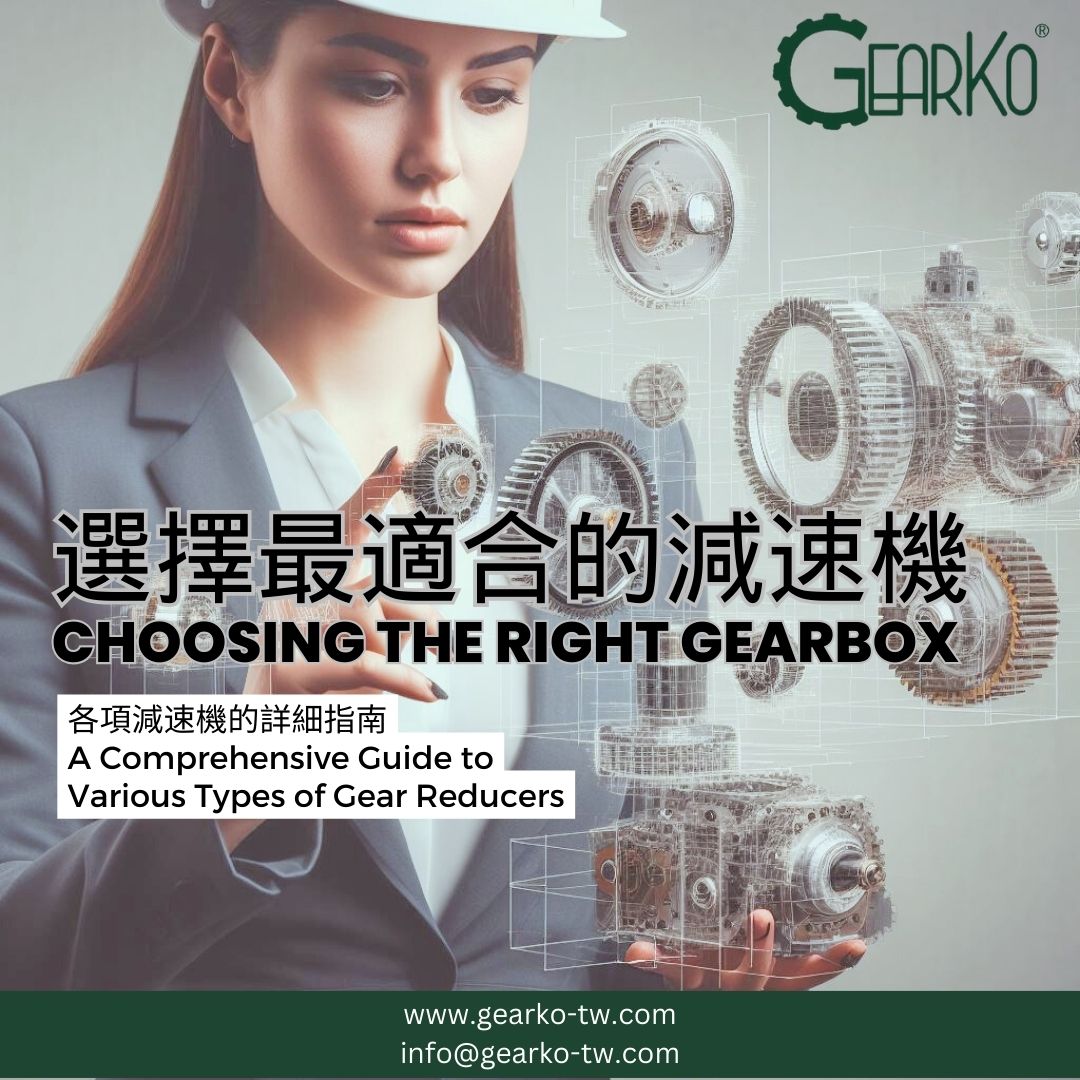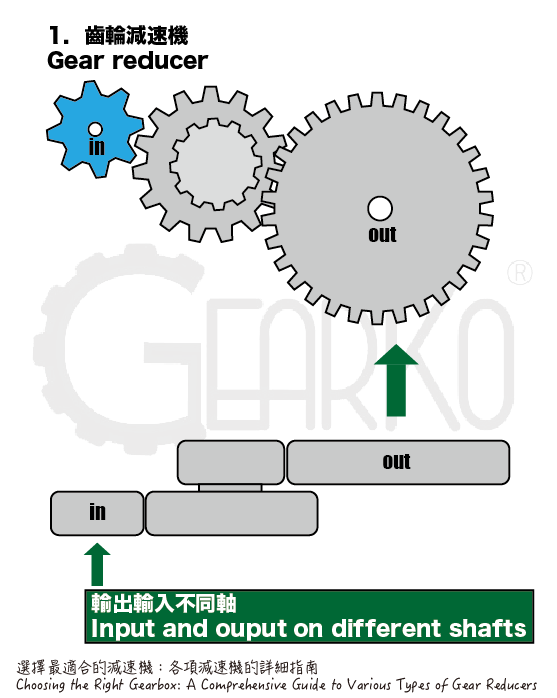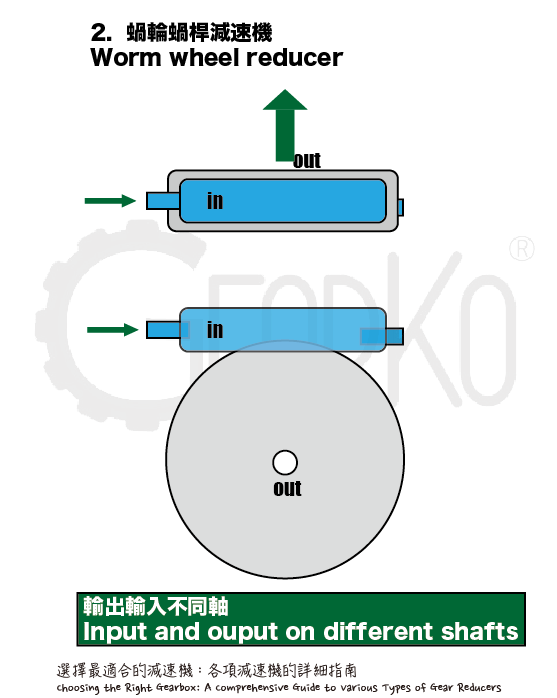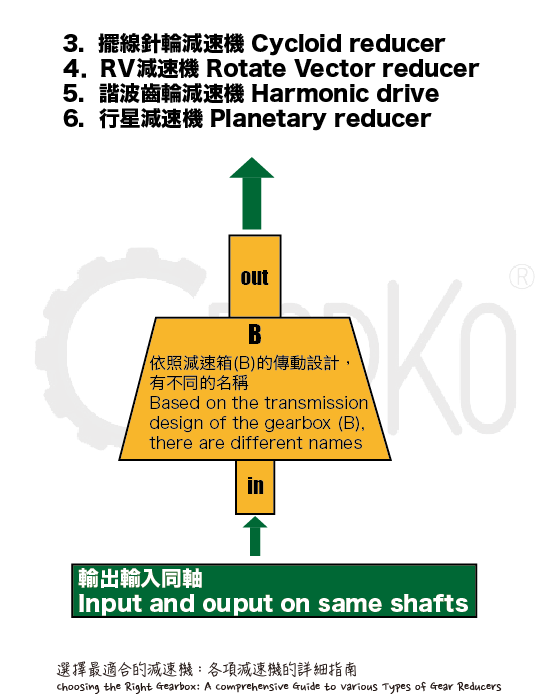2023.10.13
Choosing the Right Gearbox: A Comprehensive Guide to Various Types of Gear Reducers

Reducers can be categorized based on transmission and structural characteristics into Gear Reducer, Worm Wheel Reducer, Planetary Gears, Cycloid Reducer, Rotate Vector (RV) Reducer, and Harmonic Drive. Each of these reducers has its unique features.
Below are the characteristics and applications of each reducer.

1. Gear Reducer:
a. Advantages:
- Compact size, lightweight, high load capacity, high efficiency, long lifespan, high reliability, and finely segmented transmission ratios.
- Ideal for simple deceleration and torque increase applications.
- Simple, uncomplicated structure.
b. Disadvantages:
- Structures can be single-stage, two-stage, three-stage, or multi-stage. Each stage consists of multiple gears, and the more stages there are, the less precise it becomes.
- Lacks self-locking ability; it can drive the input shaft in reverse from the output shaft. Sudden inertial torque at the output end might reverse back to the motor shaft, causing motor damage.
c. Applications:
- Commonly used in mines, ports, aviation, construction, cranes, machinery, automobiles, etc.
- Many small motors use gearboxes. When precision isn't required, they use cylindrical gears for deceleration and torque increase. This method is cost-effective and often sold directly with motors. However, if the gearbox is damaged and the motor is still functional, individual gearboxes are available. One characteristic of these gearboxes is that the output and input shafts are parallel but not on the central axis.

2. Worm Wheel Reducer:
a. Advantages:
- Utilizes the principle of helical drive, similar to other reducers, but its reduction ratio is much larger than that of gear reducers.
- Worm gear teeth are continuous helical teeth, providing smooth transmission. Compared to gear reducers, the noise is minimal.
- The main feature is its reverse self-locking function; it can’t drive the input shaft in reverse from the output shaft.
- The input and output shafts aren’t on the same axis or plane, allowing for compact installation.
- Worm drive efficiency is lower than gear drive, especially for self-locking worm drives, which have efficiencies below 50%. Generally, efficiency ranges from 70-90%.
b. Disadvantages:
- Generally larger in size, not highly efficient, and lacks precision.
- Due to sliding friction during operation, it generates heat, which can affect the components and seals due to thermal expansion, leading to leaks.
- High heat generation leads to gear wear and increased costs.
- Installation direction has specific requirements, which affect lubrication.
- In cases where vertical installation is possible, it’s best avoided, as it requires more lubrication and increases the chances of overheating and leaks.
c. Applications:
- Widely used in mechanical industries, synthetic fiber industries, printing, automated production equipment, and other industries requiring low speed and high torque.
- Used in transportation vehicles like ships, cars, motorcycles, and heavy-duty construction machinery.
- Commonly found in everyday machines related to food, clothing, housing, transportation, education, and entertainment.

3. Cycloid Reducer:
a. Advantages:
- High transmission ratio: up to 1:87 for a single-stage reduction; up to several thousand for two stages; and tens of thousands for three stages based on actual requirements.
- High transmission efficiency due to rolling meshing, generally exceeding 90% for single-stage transmission.
- Compact size, lightweight, with input and output shafts on the same axis.
- Reliable, with fewer failures and a longer lifespan than other reducers due to all parts being in rolling friction.
- Smooth operation and low noise due to a large number of meshing teeth and a high overlap coefficient.
b. Disadvantages:
- Key components are made of bearing steel, requiring high manufacturing precision and a complex process.
- The bearing of the rotating arm is subjected to significant stress, affecting its mechanical properties.
c. Applications:
- Extensively used in industries like petroleum, environmental protection, chemicals, cement, transport, textiles, pharmaceuticals, food, printing, mining, metallurgy, construction, power generation, etc.
4. RV Reducer:
a. Advantages:
- Small size with a high reduction ratio: Consists of planetary gears and cycloid reducers, achieving higher torque from the motor in a compact size, thereby improving transmission efficiency.
- High torsional rigidity.
- High efficiency, typically above 85%.
- High precision due to the rotate vector design, with a precision of less than 1 arc minute.
- Low noise and smooth operation.
- Simple maintenance.
b. Disadvantages:
- Limited transmission ratios, especially at lower ratios.
- High cost due to numerous parts and complex manufacturing processes.
c. Applications:
- Used in industrial robots' base axis, palletizing robots, CNC machines, precision indexing plates, fourth and fifth axes, non-standard automation, medical testing equipment, satellite reception systems, etc.
5. Harmonic Drive:
a. Advantages:
- Simple and compact structure, suitable for miniaturized applications with low to medium loads.
- Small size, lightweight, and high single-stage transmission ratio.
- Stable speed and smooth operation.
- High precision, with more than 30% of the teeth meshing simultaneously, known as a zero-backlash reducer.
- Transmission efficiency around 80%.
b. Disadvantages:
- The key component, the flexible wheel, requires frequent high-speed deformation, limiting load capacity, lifespan, and rigidity compared to metal components.
- Accuracy decreases over time.
- Cannot achieve low transmission ratios, limited torque rigidity, prone to wear, and short usage cycles.
c. Applications:
- Commonly used in collaborative robots or industrial robot end-axes with small loads.
- Suitable for industries requiring precise positioning, such as robotic arms, automation equipment, semiconductor devices, machine tools, etc., offering stable repeatability and positioning ability.
6. Planetary Gear Reducer:
a. Advantages:
- Wide range of transmission ratios due to multiple planetary gear mechanisms.
- High load capacity due to multiple simultaneous gear meshing.
- High precision, with accuracies less than 1 arc minute.
- High efficiency, typically around 97%.
- Compact appearance, optimizing installation space.
b. Disadvantages:
- High cost compared to regular gear reducers.
- Difficult to achieve high precision with higher reduction ratios.
- Gears are prone to wear, resulting in higher noise levels.
- High gear manufacturing precision and complex structure.
c. Applications:
- Civil applications in automotive, food, pharmaceutical, printing, agricultural industries, satellite communications, etc.
- Industrial applications in machine tools, automated equipment, medical devices, textile machinery, packaging machines, gantry robots, parallel robots, laser cutting, AGVs, solar equipment, woodworking machines, die-cutting equipment, etc.
Conclusion:
Different types of reducers can't replace each other; they complement one another. That's why so many types of reducers are developed based on user needs and applications. However, future structural design optimization and manufacturing breakthroughs might converge their prices, leading to fewer types competing in the market.
If you have questions about selecting a reducer or any issues with usage, please contact us anytime. Feel free to call or email GearKo in Taiwan.